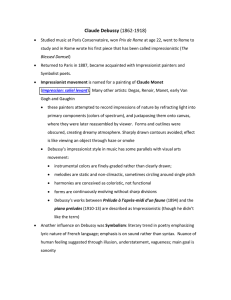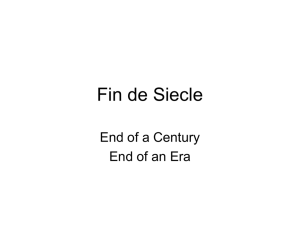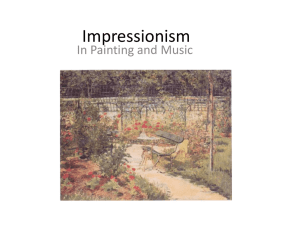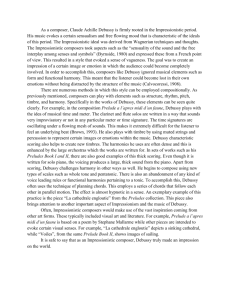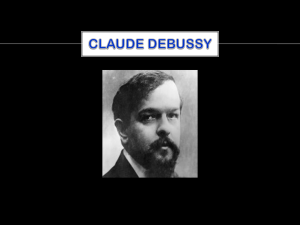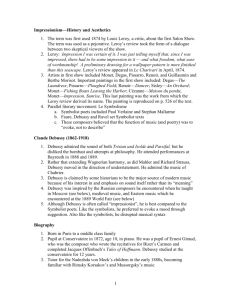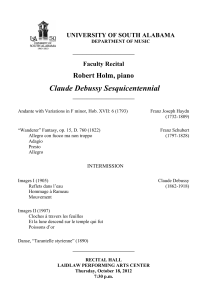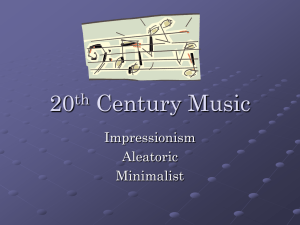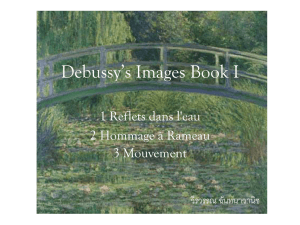DEBUSSY’S PARIS Art, Music, & Sounds of the City
advertisement
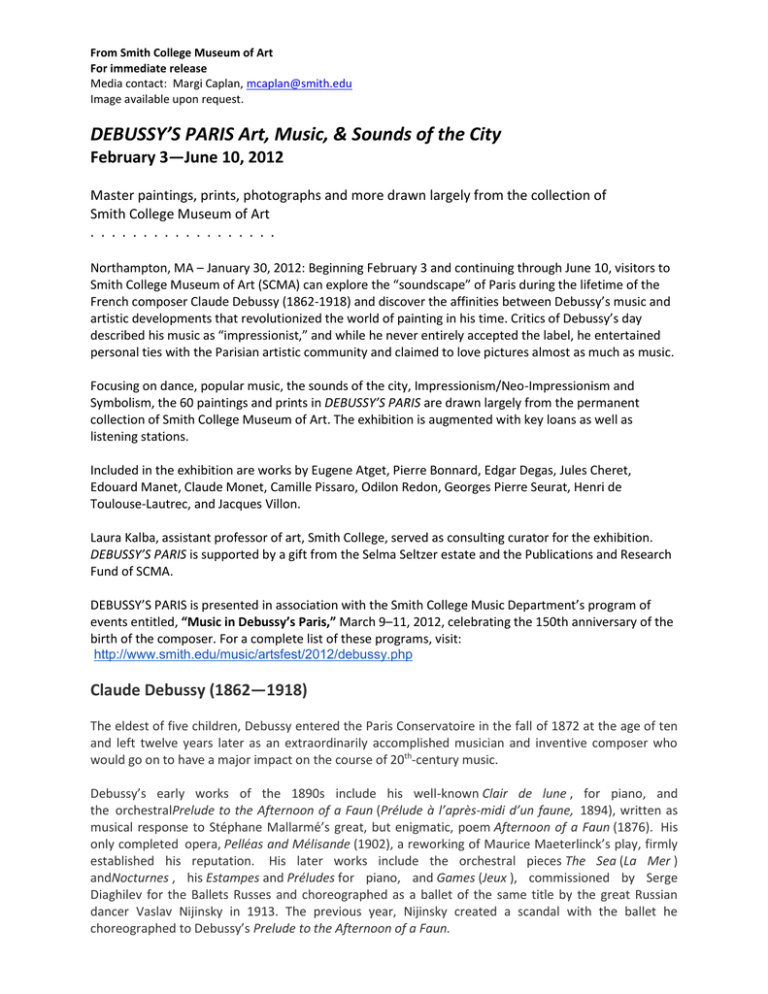
From Smith College Museum of Art For immediate release Media contact: Margi Caplan, mcaplan@smith.edu Image available upon request. DEBUSSY’S PARIS Art, Music, & Sounds of the City February 3—June 10, 2012 Master paintings, prints, photographs and more drawn largely from the collection of Smith College Museum of Art . . . . . . . . . . . . . . . . . . Northampton, MA – January 30, 2012: Beginning February 3 and continuing through June 10, visitors to Smith College Museum of Art (SCMA) can explore the “soundscape” of Paris during the lifetime of the French composer Claude Debussy (1862-1918) and discover the affinities between Debussy’s music and artistic developments that revolutionized the world of painting in his time. Critics of Debussy’s day described his music as “impressionist,” and while he never entirely accepted the label, he entertained personal ties with the Parisian artistic community and claimed to love pictures almost as much as music. Focusing on dance, popular music, the sounds of the city, Impressionism/Neo-Impressionism and Symbolism, the 60 paintings and prints in DEBUSSY’S PARIS are drawn largely from the permanent collection of Smith College Museum of Art. The exhibition is augmented with key loans as well as listening stations. Included in the exhibition are works by Eugene Atget, Pierre Bonnard, Edgar Degas, Jules Cheret, Edouard Manet, Claude Monet, Camille Pissaro, Odilon Redon, Georges Pierre Seurat, Henri de Toulouse-Lautrec, and Jacques Villon. Laura Kalba, assistant professor of art, Smith College, served as consulting curator for the exhibition. DEBUSSY’S PARIS is supported by a gift from the Selma Seltzer estate and the Publications and Research Fund of SCMA. DEBUSSY’S PARIS is presented in association with the Smith College Music Department’s program of events entitled, “Music in Debussy’s Paris,” March 9–11, 2012, celebrating the 150th anniversary of the birth of the composer. For a complete list of these programs, visit: http://www.smith.edu/music/artsfest/2012/debussy.php Claude Debussy (1862—1918) The eldest of five children, Debussy entered the Paris Conservatoire in the fall of 1872 at the age of ten and left twelve years later as an extraordinarily accomplished musician and inventive composer who would go on to have a major impact on the course of 20th-century music. Debussy’s early works of the 1890s include his well-known Clair de lune , for piano, and the orchestralPrelude to the Afternoon of a Faun (Prélude à l’après-midi d’un faune, 1894), written as musical response to Stéphane Mallarmé’s great, but enigmatic, poem Afternoon of a Faun (1876). His only completed opera, Pelléas and Mélisande (1902), a reworking of Maurice Maeterlinck’s play, firmly established his reputation. His later works include the orchestral pieces The Sea (La Mer ) andNocturnes , his Estampes and Préludes for piano, and Games (Jeux ), commissioned by Serge Diaghilev for the Ballets Russes and choreographed as a ballet of the same title by the great Russian dancer Vaslav Nijinsky in 1913. The previous year, Nijinsky created a scandal with the ballet he choreographed to Debussy’s Prelude to the Afternoon of a Faun. Like many musicians and artists of his time, Debussy was influenced by the operas of Richard Wagner, around whose work a kind of artistic, cultural, and socio-political cult known as “Wagnerianism” developed in France. Debussy, however, would eventually distance himself from the high emotionalism and drama of Wagner’s music to compose in his own original voice. The Soundscape of Paris The term “soundscape,” coined by the Canadian composer Murray Schaeffer, refers both to sound-asnoise and sound-as-music. In the context of the exhibition, “soundscape” encompasses the music French men and women heard at the opera, ballet, concert halls, and cabarets, as well as the raucous, continuous noise that came to characterize modern Paris. The exhibition is presented in three sections, allowing for the interplay of themes: “Noise and Popular Music,” “Correspondences: Art and Music,” and “Dance.” Debussy’s Paris evokes the acoustic environment of Paris not only through works of art but also through four listening stations provided: one devoted to Debussy’s music and three devoted to section themes. While viewing works by Degas, Manet, Monet, Toulouse-Lautrec and others, visitors can listen to selections of Debussy’s music, the cries of street vendors, cabaret stars Yvette Guilbert and Aristide Bruant singing popular songs, and the opening and closing stanzas of Stéphane Mallarmé’s poem “The Afternoon of a Faun.” Noise and Popular Music Debussy was an especially keen observer of Parisian street life and the music it fostered. In the exhibition, a picture of the city is conveyed in Pierre Bonnard’s prints of bustling street scenes in Paris, with their visually implied sounds of voices, traffic, and eclectic noises. Lithographs of popular entertainers and music halls by Henri de Toulouse-Lautrec and Jules Chéret evoke the boisterous atmosphere and popular songs that were performed in the cabarets and cafés -concerts of Montmartre, where Debussy occasionally played the piano. The juxtaposition of these and other works in the exhibition point toward a new kind of understanding of the relationship between art and music that had developed in Debussy’s Paris. With the expansion of lithographic printing techniques, the domain of graphic arts was expanded to include a broader range of genres, from posters and illustrated sheet music covers to original art prints and illustrated books. Music worthy of listening to moved beyond performances in prestigious concert halls and the salons of the Parisian elite. It now took to the streets to include popular songs sung by cabaret stars Aristide Bruant and Yvette Guilbert, as well as the tuneful cries of Parisian street vendors, which were featured in Gustave Charpentier’s box-office hit Louise . Debussy incorporated certain novel or “exotic” elements into his music, some of them inspired by Javanese gamelan music, which he heard at the 1889 Paris Universal Exposition. But in his own compositions, he remained essentially a purist, fending off the noises of commercial mass culture. . . . . . . . . . . . . . . . . . . . . . . . . . . . For complete information about SCMA, as well as the DEBUSSY’S PARIS exhibition website (and related programming), and sample of images from DEBUSSY’S PARIS, visit: www.smith.edu/artmuseum. For a complete roster of Smith ArtsFest 2012 offerings – including DEBUSSY’S PARIS and “Music in Debussy’s Paris” – visit http://www.smith.edu/music/artsfest/2012/debussy.php. # 30 #
